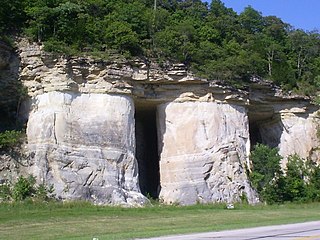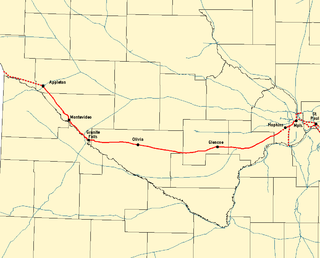
Minneapolis–Saint Paul is a metropolitan area in the Upper Midwestern United States centered around the confluence of the Mississippi, Minnesota and St. Croix rivers in the U.S. state of Minnesota. It is commonly known as the Twin Cities after the area's two largest cities, Minneapolis and Saint Paul. Minnesotans often refer to the two together simply as "the cities". The area is Minnesota's economic, cultural, and political center.

Kasota is a city within the larger Kasota Township, Le Sueur County, Minnesota, United States. The population was 714 at the 2020 census.

Minnesota State University, Mankato is a public university in Mankato, Minnesota, United States. It is Minnesota's second-largest university and has over 145,000 living alumni worldwide. Founded in 1868, it is the second-oldest member of the Minnesota State Colleges and Universities system and is commonly referred to as the flagship institution. It was established as the Second State Normal School in 1858 and officially opened as Mankato Normal School a decade later. Minnesota State University, Mankato is a significant contributor to the local and state economies, adding $827 million annually.

The St. Peter Sandstone is an Ordovician geological formation. It belongs to the Chazyan stage of the Champlainian series in North American regional stratigraphy, equivalent to the late Darriwilian global stage. This sandstone originated as a sheet of sand in clear, shallow water near the shore of a Paleozoic sea and consists of fine-to-medium-size, well-rounded quartz grains with frosted surfaces. The extent of the formation spans north-south from Minnesota to Arkansas and east-west from Illinois into Nebraska and South Dakota. The formation was named by Owen (1847) after the Minnesota River, then known as the St. Peter River. The type locality is at the confluence of the Mississippi and Minnesota Rivers near Fort Snelling, Minnesota. In eastern Missouri, the stone consists of quartz sand that is 99.44% silica.

The Minneapolis, Northfield and Southern Railway was an 87-mile (140 km) long American shortline railroad connecting Minneapolis and Northfield, Minnesota. It was incorporated in 1918 to take over the trackage of the former Minneapolis, St. Paul, Rochester and Dubuque Electric Traction Company, also known as the Dan Patch Lines. On June 2, 1982, it was acquired by the Soo Line Railroad, which operated it as a separate railroad until merging it on January 1, 1986, along with the Chicago, Milwaukee, St. Paul and Pacific Railroad.

Minnesota State Highway 280 is a 3.710-mile-long (5.971 km) highway in the Twin Cities region of Minnesota that travels from its Interchange with Interstate 94/U.S.Route 12/US Route 52 (I-94/US 12/US 52) in Saint Paul to its interchange with I-35W in Roseville.

The Twin Cities and Western Railroad is a railroad operating in the U.S. state of Minnesota which started operations on July 27, 1991. Trackage includes the former Soo Line Railroad "Ortonville Line", originally built as the first part of the Pacific extension of the Milwaukee Road. This main line extends from Hopkins, Minnesota ,to Appleton, Minnesota. The line was originally built between Hopkins and Cologne, Minnesota, in 1876 by Hastings and Dakota Railroad. In 1913, the Milwaukee Road rerouted it, reducing the curves. The line was eventually extended to the Pacific.
Purcell & Elmslie (P&E) was the most widely know iteration of a progressive American architectural practice. P&E was the second most commissioned firm of the Prairie School, after Frank Lloyd Wright. The firm in all iterations was active from 1907 to 1921, with their most famous work being done between 1913 and 1921.

Nokomis Library, formerly Nokomis Community Library, is a branch library serving the Nokomis East area of Minneapolis, Minnesota. One of 41 libraries in the Hennepin County Library system, Nokomis was designed by Buetow and Associates, Inc and opened in 1968 as a replacement for the nearby Longfellow Community Library. After being deemed crowded and outdated in 1999, the library underwent a renovation beginning in 2009 that saw it gain a number of environmentally friendly features and an expansion of 4,300 square feet (399 m2). The building reopened in 2011 and includes a restored Wind and Water Chime, a stabile that was part of the original library and that was refurbished and reinstalled by July 2013. The library contains over 35 computers, a public meeting room, and a Spanish-language collection of materials.

The Woodbury County Courthouse is located at 620 Douglas Street in Sioux City, the county seat of Woodbury County, Iowa, United States. It is regarded as "one of the finest Prairie School buildings in the United States" and has been declared a National Historic Landmark for its architecture. It is used for legal proceedings in the county.
This is an incomplete list of historic properties and districts at United States colleges and universities that are listed on the National Register of Historic Places (NRHP). This includes National Historic Landmarks (NHLs) and other National Register of Historic Places listings. It includes listings at current and former educational institutions.
Alexander Chadbourne Eschweiler was an American architect with a practice in Milwaukee, Wisconsin. He designed both residences and commercial structures. His eye-catching Japonist pagoda design for filling stations for Wadham's Oil and Grease Company of Milwaukee were repeated over a hundred times, though only a very few survive. His substantial turn-of-the-20th-century residences for the Milwaukee business elite, in conservative Jacobethan or neo-Georgian idioms, have preserved their cachet in the city.

The Platteville Limestone is the Ordovician limestone formation in the sedimentary sequence characteristic of the upper Midwestern United States. It is characterized by its gray color, rough texture, and numerous fossils. Its type locality is Platteville, Wisconsin. It was heavily used in the early decades of the building of Minneapolis–Saint Paul and Faribault, Minnesota.
Broadway Across America (BAA) is a presenter and producer of live theatrical events in the United States and Canada since 1982. It is currently owned by the John Gore Organization, which purchased it from Live Nation in 2008.
Morton gneiss, also known as rainbow gneiss, is an Archean-age gneiss found in the Minnesota River Valley of southwestern Minnesota, United States. It is one of the oldest stones on Earth, at about 3.5 billion years old. Along with the nearby Montevideo Gneiss, it is the oldest intact continental crust rock in the United States. Its type locality is in Morton, Minnesota.
The MN&S Spur is a 18.5-mile (29.8 km) railroad line operated by the Progressive Rail Inc. The route runs through suburbs immediately west of Minneapolis, Minnesota, from MN&S Junction in Crystal south to Auto Club Junction in Bloomington near the Minnesota River. This path is parallel to Minnesota State Highway 100, which is about half a mile east of the rail line.
The Northern Great Plains History Conference is an annual conference of history professors, graduate students, historical society experts, and other scholars interested in the history of the Great Plains states of the American Midwest. The Conference features scholarly papers by academics and advanced students on a variety of topics, especially in social history and military history, as well as regional topics regarding the Great Plains.
The Minnesota State University campus currently contains 30 buildings spread over 303 acres (123 ha) in Mankato, Minnesota, United States. The campus includes on campus housing in the form of dorms for 2,700 residents, academic buildings, a main library, a music library, two astronomy observatories, experimental research stations for alternative and renewable energy, a recreation center, an athletics complex, a student center, an administration center and over 50 acres of athletics fields including the football team Blakeslee Stadium. The Minnesota State Mavericks men's and women's hockey teams also utilize and have administrative space at the Verizon Wireless Center and the All Seasons Arena located off campus.

The Shanaska Creek Bridge, also called Washington Park Bridge and officially Bridge 4846, is an iron 8 panel pin-connected Pratt through truss bridge which was erected in 1875 over the Blue Earth River in the U.S. State of Minnesota and moved twice since. It was built near Vernon Center, Minnesota by Soulerin, James, and Company of Milwaukee, Wisconsin.

The Minneapolis Veterans Affairs Health Care System (VAHCS) is network of hospital and outpatient clinics based in Minneapolis, Minnesota, USA. It belongs to the VISN23 VA Midwest Health Care Network managed by the Veterans Health Administration of the Department of Veterans Affairs. The Minneapolis VAHCS provides healthcare for United States military veterans in areas such as medicine, surgery, psychiatry, physical medicine and rehabilitation, neurology, oncology, dentistry, geriatrics and extended care. As a teaching hospital, it operates comprehensive training programs for multiple treatment specialties. The Minneapolis VAHCS also hosts one of the largest research programs of any VA health care system and maintains research affiliations with the University of Minnesota.















